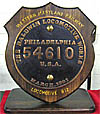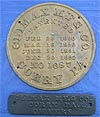|
|
Builders
Plates
Builders plates are cast or stamped metal plates that are affixed to
locomotives and other railroad equipment. According to Steuernagel (1988), "The
'builders plate' ... serves
the same purpose as the birth certificate of humans. The plate tells
the builders name, the sequential number of construction, usually the
month and year of construction, and location of the builder. Some builders
plates contain additional information such as the classification of the
locomotive or specifications." When locomotives are retired and scrapped,
builders plates are one of the few things that are sometimes salvaged
from the locomotive frame, and these have become a special focus for
many railroadiana collectors.
Some points about builders plates:
- In the early days of steam locomotive construction,
builders plates
were mounted in various places on the locomotive; however after
about 1880, they were usually mounted on the smokebox,
at least in the U.S. and Canada. The smokebox is the front segment
of the cylindrical profile of a steam locomotive. Plates were mounted
roughly in line with the smokestack and were generally
applied two per locomotive -- one on each side.
- According to Steuernagel, "Five railroads -- B&O,
KCS, New Haven, N&W, and PRR - for many years required that the
builders plates also include the class of the locomotive on some or
all of their locomotives, and that the builders plates be of a particular
shape. ... The prime example of a road which required the builders
plate to be of a specific shape and size and to include specific information
in a specific format was the Pennsylvania Railroad. In 1891, the
PRR began using oval plates on locomotives constructed in their own
shops. ... A few years later, the PRR required that all locomotives
received from other locomotive builders be delivered with similar
styled builders plates designed from drawings supplied by the PRR."
-
Many commercial companies have manufactured
locomotives, so there are a variety of corresponding plates
in different shapes and sizes. There were three major steam
locomotive manufacturers in the United States -- Baldwin Locomotive
Works, ALCO (American Locomotive Company), and Lima Locomotive Works,
but these were preceded by a number of smaller companies,
including Cooke, Pittsburgh, Dickson, Richmond, and others. In fact,
ALCO was formed by a merger that eventually included ten former manufacturers
( See
article on this). There
were also specialty steam locomotive manufacturers such as Heisler,
Willamette, Porter, Vulcan, and others. Electric locomotives were primarily
represented by the Westinghouse and General Electric companies, which
typically made locomotives in association with other manufacturers.
Diesel locomotives have been made by the Electro Motive Division of
General Motors (EMD), General Electric (GE), and in the early
years, some the major steam locomotive builders, either individually
or as merged companies, e.g., Baldwin-Lima-Hamilton. There have
also been specialty diesel locomotive manufacturers such as Plymouth,
and major rebuilders such as Morrison-Knudson.
- In addition to the commercial manufacturers, a number of railroads
constructed steam locomotives in their own shops, and these locomotives
carried plates for those shops. Among the more famous railroad shops
that built steam locomotives were the Juniata Shops of the Pennsylvania
Railroad, the Roanoke Shops of the Norfolk & Western Railway,
and the Paducah Shops of the Illinois Central Railroad. In more modern
times, some railroad shops became known for extensive remanufacturing
of diesel locomotives.
- Steam locomotive and very early diesel locomotive plates tended
to be made of cast metal -- usually either iron or brass. Aluminum
was used later with some diesel plates. Some first-generation
diesel plates look very much like steam locomotive plates, mostly because
the builders were former steam locomotive builders and retained their
old practices. Later diesel locomotive manufacturers such as EMD and
GE tended to use stamped, steel plates and continue this practice to
the present.
- Most builders plate collectors focus attention on locomotive
plates, but there are other equipment plates that may be of interest
such as trust or lease plates from rolling stock, builders plates
from major railroad equipment such as steam derricks and plows, and
plates from sub-components of locomotives such as superheaters. There
were also many industrial machines and structures
related to railroads that were adorned with builders plates -- such
as logging equipment and bridges.
- Many builders plates were not saved, especially in the early
days of railroading, so all plates are considered rare (although to
varying degrees) and priced accordingly. Most collectors
focus on cast, steam-era plates, although diesel plates are picking
up in popularity. Relatively recent steam-era plates can go for $400-$600
and up; early, pre-1900 plates can go for thousands.
- Like other railroadiana fields, the builders plate category has
been plagued by fakes and reproductions -- some that are out in the
open and some that are more insidious. A whole series of resin reproductions
has been made and are fairly easy to detect, at least in person. See page
on this topic. The more insidious types are
the cast metal reproductions which may be passed off as originals.
See fakes.
- Unlike some types of railroadiana, builders plates continue
to be made and applied to new locomotives, so future
collectibles are still being produced. However, it must be stated
in the strongest terms possible that removing plates from existing
equipment not only is unethical and illegal -- pure theft -- but it
gives the hobby a bad name. The only legitimate focus for the collector
is the plate that has been removed by owners from retired or salvaged
equipment.
Closely allied with the builders plate is the
number plate. On steam locomotives, this was a square or round plate,
usually of cast metal, that indicated the assigned number of the
locomotive and sometimes additional information like the builder. On
most North American railroads, there was a single number plate per steam
locomotive, although a few roads such as the Richmond, Fredericksburg
& Potomac used cast number plates on the sides of the cab. In the
diesel era, cast number plates gave way to number boards, either with
removable individual numerals or, later on, plastic inserts.
Following are some examples of builders plates and number plates, all
shown with permission. Thanks to everyone who allowed us to use
their photos!
 |
 |
 |
 |
| Above left to right. A Baldwin
Locomotive Works builders plate from a Union Pacific 2-10-2 steam
locomotive; a Baldwin Locomotive
Works plate, mounted on a plaque, from Western Maryland
Railway steam locomotive #812; a Baldwin Locomotive Works number
plate from steam locomotive #32 (previously thought to be from the East Broad Top Railroad, but we have been told that the highest EBT locomotove was #18);
a beautiful and rare builders plate from the Rhode Island Locomotive
Works, which eventually became part of ALCO. |
 |
 |
 |
 |
| Above left to right. A
builders plate from the Richmond Works of the American Locomotive
Company (ALCO); a Brooks Works -- also part of ALCO -- plate from
a Union Pacific 2-10-2 steam locomotive; an
ALCO plate from a Bessemer & Lake
Erie 2-10-4 steam locomotive; a plate from an ALCO diesel switcher. |
 |
 |
 |
 |
| Above
left to right. An assortment of builders plates
from the Lima Locomotive Works; a plate from a "Shay" locomotive
built by Lima Locomotive Works; a diesel
plate from the Lima-Hamilton Corporation; a plate from
the H.K. Porter Company. |
 |
 |
 |
 |
| Above
left to right. A
builders plate and additional manufacturer's identification plate
from a steam logging locomotive made by the Climax Manufacturing Company; a
plate from a class Y5 articulated steam locomotive built by the
Roanoke Shops of the Norfolk & Western
Railway; a keystone nose plate from a Pennsylvania
Railroad class G-5 steam locomotive; a rare wooden mold used
to form the sand mold for casting a keystone nose plate for
a PRR class T1steam locomotive. |
 |
 |
 |
 |
| Above
left to right. A builders plate
from a Pennsylvania Railroad (PRR) class J1 steam locomotive
built at the Altoona Works of the PRR; a
display of various builders plates from PRR steam locomotives;
builders plates from PRR GG1 and P-5 electric
locomotives; two diesel locomotive builders plates from the
Electro Motive Division of General Motors. |
 |
 |
 |
 |
| Above
left to right. A brass number plate from Southern
Railway Engine #880, a 2-8-0 Consolidation; a number plate from
a berkshire (2-8-4) steam locomotive owned by the Chesapeake & Ohio
Railway; a builders plate for a Pullman Standard car;
a trust plate from a railroad car. |
 |
 |
 |
 |
| Above
left to right. Three views of a PRR J1 builder's plate believed to be authentic. Note the scale and rust on the front, sides and back. Photos courtesy of Pam W. The number plate in the fourth photo was found in the 1960's along a former railroad roadbed in New Jersey. An inquiry to Erie-Lackawanna resulted in a letter identifying it as a number plate from a narrow gauge locomotive used by a predecessor line. Thanks to BH for the photo. |
PRR Number Plate Drawing - added September, 2017. Here are two views of a Pennsylvania Railroad number plate drawing, courtesy of Bill Lane. These are big files, so download speed may be slow, depending on your connection. View 1 View 2
Sources.
- Moore, Tim and Muldowney, Ron. "Pre-Alco and Early Builders
Plates"
(1983). Key Lock & Lantern, pp. 1098-1106. See
this article.
- Muldowney, Ron and Moore, Tim. "The American Locomotive Company
Builders Plates" (1991). Key, Lock & Lantern, pp 2020-2027. See
this article.
- Steuernagel, Elmer. "Railway Identification Plates".
(1988). The Railroadiana Express, pp 24-30.
|